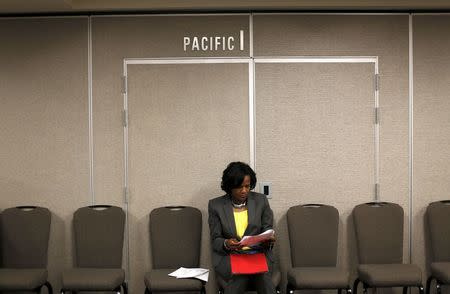Weak U.S. productivity, rising labor costs stir inflation concern
By Lucia Mutikani
WASHINGTON (Reuters) - U.S. nonfarm productivity fell more sharply than initially thought in the first quarter, leading to a jump in labor-related production costs, a trend that could ignite inflation if sustained.
Other data on Thursday showed the labor market tightening, with first-time applications for unemployment aid falling last week and the number of people on benefit rolls hitting the lowest level since 2000. The reports likely keep the Federal Reserve on track to raise interest rates later this year.
"It's not our base case, but should productivity growth remain muted, this would increase the risk for a more rapid pickup in inflation and potentially require a faster hiking cycle than the Fed currently foresees," said Michael Hanson, an economist at Bank of America Merrill Lynch in New York.
Productivity fell at a 3.1 percent annual rate instead of the previously reported 1.9 percent pace, marking the first back-to-back fall since 2006, the Labor Department said. It rose only 0.3 percent from a year ago.
According to JPMorgan, productivity was up a meager 0.6 percent annualized over the past five years, the worst five-year run since the early 1980s and the worst five-year performance on record outside of a recession.
The data came as the International Monetary Fund, in its annual assessment of the U.S. economy, said the U.S. central bank should delay hiking rates until the first half of 2016.
U.S. financial markets were largely unmoved by the data as investors focused on a global bond sell-off. The dollar fell against the euro while U.S. stocks were trading lower. Prices for U.S. Treasury debt rose.
While the productivity decline mirrors the economy's dismal performance in the first quarter, when gross domestic product contracted at a 0.7 percent rate, it has also been stifled by inadequate investment in capital.
INVESTMENT LACKING
"The labor productivity trend has been crushed by lack of investment leading to an unprecedented decline in capital intensity. The ratio of capital services per hour worked fell slightly in 2011, 2012, and 2013, the first run of three declines on record," said Ted Wieseman, an economist at Morgan Stanley in New York.
But the drop in first-quarter productivity could be overstated, given a confluence of temporary factors that weighed on GDP. A rebound is expected in the second half of the year as businesses spend more on research and development, as well as on software and equipment.
Still, weak productivity suggests the economy's potential growth could be lower than the 1.5 percent to 2.0 percent pace economists currently estimate.
Unit labor costs, the price of labor per single unit of output, increased at an upwardly revised 6.7 percent rate in the first quarter, the fastest pace in a year. They were previously reported to have increased at a 5.0 percent rate.
Unit labor costs rose at a 1.8 percent pace compared to the first quarter of 2014, a sign wage inflation is benign for now.
"The Fed is assuming a rebound in productivity which will allow them to gradually tighten monetary policy. If the current trend continues into 2016 and 2017, the Fed will have to tighten monetary policy much more quickly," said Ryan Sweet, a senior economist at Moody's Analytics in West Chester in Pennsylvania.
In another report, the Labor Department said initial claims for state unemployment benefits dropped 8,000 to a seasonally adjusted 276,000 for the week ended May 30. It was the 13th straight week that claims held below the 300,000 threshold, which is usually associated with a strengthening labor market.
The tightening jobs market underscores the economy's solid fundamentals even though growth is struggling to regain steam.
The economy got off to slow start in the second quarter in part because a strong dollar and spending cuts in the energy sector constrained manufacturing activity.
There are, however, signs of some pickup, with data this week showing a surge in automobile sales in May and gains in factory activity for the first time since November. In addition, the trade deficit narrowed sharply in April and construction spending hit its highest level since November 2008.
Thursday's claims report showed the number of people still receiving benefits after an initial week of aid fell to its lowest level since November 2000.
(Reporting by Lucia Mutikani; Editing by Paul Simao)


